It is important that lawn pests are identified before they cause extensive damage to your lawn. The earlier they are identified and treated, the more minimised the damage will be. Most insects & pests can easily be controlled with a single treatment application, while some can take a little longer to be completely effective.
Contact your local Lawn Master representative for details on how best to approach each lawn pest, or you can find out more about common lawn pests below.
There are several ways of identifying lawn pests in your lawn, these include:
If you think that your lawn has chafer grubs or leatherjackets, then you should contact your local Lawn Master expert representative as soon as possible.
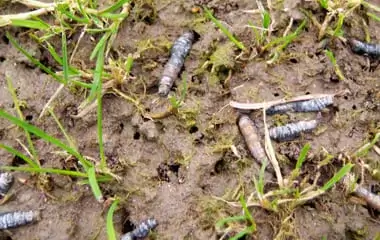
Leatherjackets are the larvae of crane flies (daddy-long legs), which are a common nuisance in some lawns. These pests are 30-40mm long and can cause significant damage when left untreated.
Between July and September, crane flies lay eggs in lawns, which later hatch around 2-3 weeks later as the larvae. Once they have hatched, they start feeding off the turf roots, essentially destroying the turf. Leatherjackets can feed throughout these months, all the way into the following June.
The main problem with Leatherjackets is that it isn’t usually obvious that they are present until significant damage has been caused. The first visible signs are when patches of the lawn turns straw-coloured and then become bare. These areas then usually become weed infested. The next indication is when birds start regularly pecking at the lawn in order to get to the Leatherjackets, so that they can eat them.
Leatherjackets can easily be controlled with a treatment application. In order to help avoid the damage that these pests cause, areas of the turf should be checked on a regular basis to see if any larvae are present. The earlier they are identified and treated, the more minimised the damage will be.
Lawn Master is fully licensed to apply safe and effective treatments for Leatherjackets, following manufacturer guidelines. While our initial treatments are typically effective, we cannot guarantee 100% success with a single application. If follow-up treatments are required, they will be charged at the same rate as the initial service.
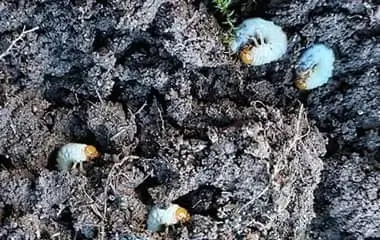
These are the soil-dwelling larvae of Chafer beetles, which feed on grass plant roots. The damage that these pests cause is similar to that of Leatherjackets, but far more extreme. When an area of turf is infested with Chafer Grubs, birds and large animals such as badgers start to attack the area in an attempt to eat the grubs.
In extreme cases, significant damage can be caused in just a few days.
Chafer Grubs reach maturity between autumn and winter. Therefore, this is when the damage is more obvious. Areas of the grass will become yellow, and the turf can easily be pulled back by hand.
Chafer Grubs can be treated with specific products, but the products can take a little longer to be completely effective when compared to Leatherjacket treatments.

There are approximately 16 species of earthworms likely to be found in lawns across Britain, in varying sizes and colour. All of these worms contribute to creating high quality soil structure and fertility.
However, when casting worms start to leave deposits of soil on the surface of a lawn, they can quickly become a nuisance. Earthworms can be active throughout most of the year, but are most active between February and April. These worms are scarce in soils that are high in acidity and prone to water logging.
Worm casts are material that the worms have eaten, which passes through and is then excreted onto the surface of the lawn. These casts cause a problem because they can quickly make a lawn become muddy and uneven. Worm casts can easily be stopped by applying a treatment that will force the worms further down the soil, away from the surface of the lawn.
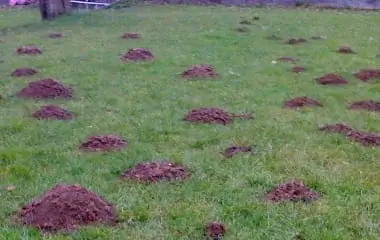
For most people, moles in a lawn are never a problem. However, for the minority of unfortunate people who have a mole problem, the damage can be quite significant.
Moles do not damage the grass, but the molehills look unsightly and can be annoying when trying to mow the lawn. They prefer moist and loose soils that are shaded, as they cannot live as easily in hard, compact areas. Moles eat earthworms therefore; a worm treatment can help deter moles by moving their food source.
Most moles are quite territorial; therefore usually there is only 1 mole in an average sized lawn. If moles become an issue, approved licensed control methods can be used. Some of our outlets are certified for the use of these specialist products.
Alternatively, the food supply can be removed to encourage them to move to a more productive food area.
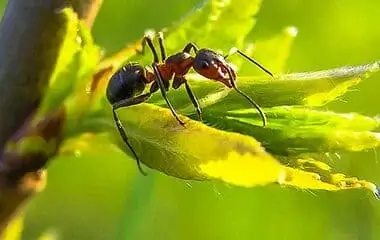
There are 41 species of ants living in the UK. The garden (or black ant) can be a nuisance in lawns when nests are large. Their nests can create an uneven lawn surface, as well as being an eyesore.
Some species of ants can be killed, whereas others are much harder to control. In most cases, ants are best left alone. However, some treatments can be recommended if they become a major problem.
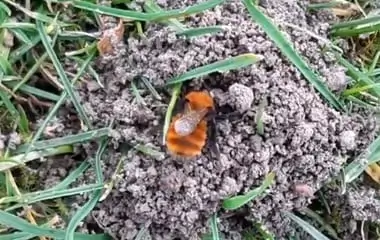
If you’re noticing a lot of small holes appearing in your lawn, then mining bees are nesting in your lawn.
Mining bees are perfectly harmless and won’t cause any problems to your lawn’s health. The “volcano like” appearance that they create just looks unsightly when there are many of them scattered across your lawn.
Female bees will typically create holes in your lawn so that they can create a nest to lay and protect their eggs in. The deepness of the holes vary in size, usually depending on how many places the eggs are kept in.
These type of insects don’t harm your lawn in any way, therefore there is usually no reason to attempt to remove them. They are generally valuable pollinators to your garden.
To stop the holes and soil deposited on the surface from being so noticeable, you can brush the soil gently to make them less noticeable, although the mess will likely appear again within a short period of time.
In the rare occasion that your lawn becomes heavily infested and looks very unsightly, methods are available to remove the bees. You should ask your local Lawn Master representative about these solutions to avoid the mess from continuing.
Signs of lawn pest infestation may include brown patches, holes or ripped areas of the lawn, increase in wildlife activity and overall decline in lawn health.
Initially, you should inspect your lawn for signs of lawn pests such as brown patches, thin or wilted grass and the presence of insects by using a spade or knife to cut out a small area of the lawn. We would advise you to then contact your local Lawn Master expert if you find any evidence of insects
The main damage is a decline in lawn health, which is associated with the pests feeding on grass roots, which in turn kills the lawn off.
There is nothing to guarantee prevention, but having your lawn regularly maintained will certainly allow it to withstand the damage of an infestation much better than a lawn that is not being maintained.
312+ Lawn Care Professionals Employed Nationwide
